AGRICULTURAL SCIENCES PAPER 2 GRADE 12 QUESTIONS - AMENDED SENIOR CERTIFICATE EXAMS PAST PAPERS AND MEMOS MAY/JUNE 2018
Share via Whatsapp Join our WhatsApp Group Join our Telegram GroupAGRICULTURAL SCIENCES
PAPER 2
GRADE 12
AMENDED SCE PAST PAPERS AND MEMOS
MAY/JUNE 2018 2018
INSTRUCTIONS AND INFORMATION
- This question paper consists of TWO sections, namely SECTION A and SECTION B.
- Answer ALL the questions in the ANSWER BOOK.
- Start EACH question on a NEW page.
- Number the answers correctly according to the numbering system used in this question paper.
- You may use a non-programmable calculator.
- Show ALL calculations, including formulae, where applicable. 7. Write neatly and legibly.
QUESTIONS
SECTION A
QUESTION 1
1.1 Various options are provided as possible answers to the following questions. Choose the answer and write only the letter (A–D) next to the question number (1.1.1 to 1.1.10) in the ANSWER BOOK, e.g. 1.1.11 B.
1.1.1 The process of designing and developing the product to suit the needs of consumers is …
- selling.
- trading.
- marketing.
- branding.
1.1.2 A measure of how much the demand for a product changes if there is a change in price is known as ...
- elasticity of demand.
- inelasticity of demand.
- elasticity of supply.
- inelasticity of product.
1.1.3 The law of demand states that …
- the greater the number of consumers, the lower the demand for a specific product.
- when the price of a product decreases, the demand for it increases.
- the higher the income, the less demand for a specific product.
- when the price of a product increases so does the demand.
1.1.4 The following are the reasons for drawing up an agribusiness plan:
- To determine whether it will be possible to implement the idea with success
- To pay back the loan obtained from Land Bank
- To guide daily operations
- To determine the money needed for the business
Choose the CORRECT combination:
- (i), (ii) and (iv)
- (ii), (iii) and (iv)
- (i), (ii) and (iii)
- (i), (iii) and (iv)
1.1.5 The labour legislation that regulates farm workers' leave and working hours:
- Occupational Health and Safety Act, 1993 (Act 85 of 1993)
- Unemployment Insurance Act, 2001 (Act 63 of 2001)
- Basic Conditions of Employment Act, 1997 (Act 75 of 1997)
- Labour Relations Act, 1995 (Act 66 of 1995)
1.1.6 The net worth of a farming enterprise is defined as …
- the owner's equity.
- expenditure minus income.
- assets plus liabilities.
- the value of assets minus liabilities.
1.1.7 An example of a whole-farm budget with more than one enterprise:
- Expected income and expenses for cabbage seedlings, fertiliser and insecticides
- Estimated income and expenses for the production of maize, beef and fodder
- Estimated expenses for the production of wool sheep
- Expected expenses for the production and selling of lucerne
1.1.8 The ability to proactively deal with challenges that might occur in future:
- Integrated farm management
- Strategic farm management
- Organisational farm management
- Problem-solving farm management
1.1.9 A large increase in growth and productivity of the offspring compared to the parents:
- Heterosis
- Heritability
- Heterozygous
- Homozygous
1.1.10 Hereditary change in the genetic material of the offspring:
- Atavism
- Prepotency
- Mutation
- Variation (10 x 2) (20)
1.2 Choose a term/phrase from COLUMN B that matches a description in COLUMN A. Write only the letter (A–J) next to the question numbers (1.2.1 to 1.2.5) in the ANSWER BOOK, e.g. 1.2.6 K.
COLUMN A | COLUMN B |
1.2.1 Profit driven |
|
(5 x 2) (10)
1.3 Give ONE word/term for EACH of the following descriptions. Write only the word/term next to the question numbers (1.3.1 to 1.3.5) in the ANSWER BOOK.
1.3.1 The process of attracting consumers to buy a product by advertising on television and the radio
1.3.2 The items that have financial value and are owned by a farmer
1.3.3 Purposeful breeding of plants and animals which is done to get new varieties of species
1.3.4 The use of statistics to analyse the biological data of an individual to determine its breeding value
1.3.5 The expression of one gene that is controlled by another gene on a chromosome (5 x 2) (10)
1.4 Change the UNDERLINED WORD in EACH of the following statements to make it TRUE. Write only the answer next to the question numbers (1.4.1 to 1.4.5) in the ANSWER BOOK.
1.4.1 Market is calculated by adding a certain percentage to the production input in order to make a profit.
1.4.2 Flexibility is an approach used by a manager to reduce the impact of changes in a market by using future contracts.
1.4.3 Dominance is the visible characteristics produced from individual genotypes.
1.4.4 A chromosome is a section of the DNA that contains information for a particular genetic characteristic.
1.4.5 Prepotency is the reappearance of an ancestral characteristic in an organism after it has been absent for many generations. (5 x 1) (5)
TOTAL SECTION A: 45
SECTION B
QUESTION 2: AGRICULTURAL MANAGEMENT AND MARKETING
Start this question on a NEW page.
2.1 The picture below illustrates a marketing channel used by farmers in a free marketing system. 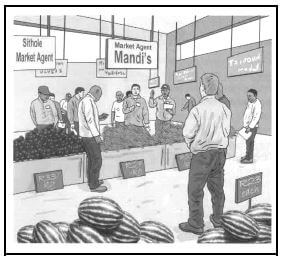
2.1.1 Identify the marketing channel illustrated above. (1)
2.1.2 State TWO advantages of the marketing channel identified in QUESTION 2.1.1. (2)
2.1.3 Give TWO disadvantages of a free marketing system for a producer. (2)
Producers put their farm produce together and sell as a collective. This is done to eliminate the problem of producing and marketing their produce as individuals. |
2.2
2.2.1 Name the marketing system illustrated above. (1)
2.2.2 Name the system whereby farm produce from various farms is brought together and marketed as one mass. (1)
2.2.3 Indicate THREE ways in which producers can benefit from this system in QUESTION 2.2.2. (3)
2.3 The table below shows two competing agricultural products and the quantities demanded at different prices.
QUANTITY DEMANDED PRODUCT 1 (kg) | QUANTITY DEMANDED PRODUCT 2 (kg) | PRICE (Rand) |
90 | 150 | 10 |
80 | 140 | 20 |
70 | 140 | 30 |
60 | 130 | 40 |
50 | 130 | 50 |
40 | 120 | 60 |
30 | 110 | 70 |
20 | 100 | 80 |
10 | 100 | 90 |
2.3.1 Indicate TWO factors, other than price, that might have influenced the demand of PRODUCT 2. (2)
2.3.2 Indicate the trend of quantities demanded at different prices of PRODUCT 2. (2)
2.3.3 Draw a line graph showing the quantities demanded of PRODUCT 1 at different prices. (6)
2.3.4 Deduce the relationship between price and quantity demanded for PRODUCT 1. (2)
2.4 The illustration below indicates an agribusiness chain. 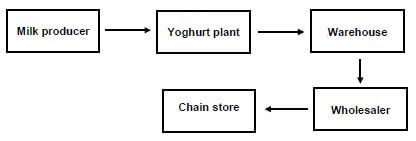
From the agribusiness chain above, identify the component that relates to EACH of the following statements.
2.4.1 Yoghurt is sold to retailers in large quantities. (1)
2.4.2 A variety of heavy machines and equipment is used to make yoghurt. (1)
2.4.3 The yoghurt is displayed in smaller and more consumer-friendly units. (1)
2.4.4 The primary product is sold at the lowest price. (1)
2.4.5 The yoghurt is placed in boxes and staged in pallets. (1)
2.5 The graph below shows the price trend of two agricultural products over a six-months period. 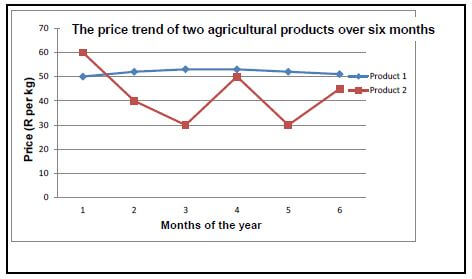
2.5.1 Identify the product which is responsive to seasonal changes. (1)
2.5.2 Explain the effect of seasonal production on the price of the product identified in QUESTION 2.5.1. (2)
2.5.3 Give ONE reason related to production, which has led to the constant price of Product 1. (1)
2.6 Name FOUR phases of the entrepreneurial process. (4) [35]
QUESTION 3: PRODUCTION FACTORS
Start this question on a NEW page.
3.1 Land is the most important production factor.
3.1.1 Name TWO economic characteristics of land. (2)
3.1.2 Suggest TWO measures to improve the productivity of land. (2)
3.1.3 Indicate TWO functions of land as a production factor. (2)
3.2 The pictures below show activities on a farm that are regulated by legislation.
3.2.1 Name the labour legislation that regulates EACH of the following: 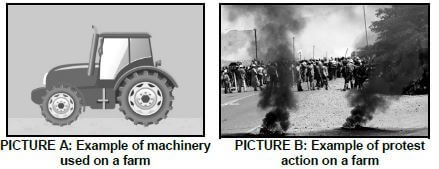
- Ensures that the farm worker using the machinery in PICTURE A is safe (1)
- Allows for the protest action of the farm workers in PICTURE B (1)
- Protects the farm worker using the machinery in PICTURE A if he/she is injured while on duty (1)
- The farm worker using the machinery in PICTURE A is working within the stipulated time (1)
3.2.2 Identify the type of farm worker who has been operating the machinery in PICTURE A for 20 years. (1)
3.2.3 Suggest TWO labour issues that might have led to the protest actions of farm workers in PICTURE B. (2)
3.2.4 Indicate TWO measures the farmer can take to address the labour issues in QUESTION 3.2.3. (2)
3.3
A family received a pension package of R1 189 000 which was invested in a 15 ha piece of land. As they had no capital they applied for and received a loan of R280 000 from the bank. They used R50 000 for a borehole, R158 000 for a tractor and R15 000 for pesticides, seeds and fertilisers. |
3.3.1 Identify an example of a capital item in the scenario above which is categorised as follows:
- Movable capital (1)
- Working capital (1)
- Fixed capital (1)
3.3.2 Name TWO sources of capital used by the family in the scenario above. (2)
3.3.3 Calculate the total value of the assets of this farming enterprise. (2)
3.3.4 In the scenario above, deduce TWO problems associated with capital as a production factor. (2)
3.4 The steps below form part of the decision-making process.
A. Evaluate alternatives.
B. Identify the problem with regard to its importance.
C. Choose and follow the best solution.
D. Analyse possible alternatives.
3.4.1 Rearrange the steps above in the CORRECT sequence. Write down only the letters (A–D) next to the question number (3.4.1). (4)
3.4.2 Give TWO factors which influence the effectiveness of the decision-making process. (2)
3.5 The picture below shows a farm with different operations that are managed successfully. 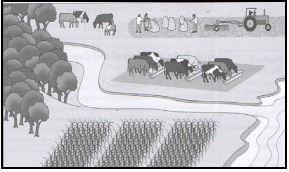
3.5.1 Identify the risk management strategy shown in the picture above. (1)
3.5.2 Justify the answer to QUESTION 3.5.1. (1)
3.5.3 Name the management skill that has enabled the manager to decide on the strategy in QUESTION 3.5.1 in advance. (1)
3.5.4 Give TWO examples of production risks that can directly affect the operations of the farming enterprise above. (2) [35]
QUESTION 4: BASIC AGRICULTURAL GENETICS
Start this question on a NEW page.
A farmer received four pigs as a gift from a neighbour.
The farmer decided to divide them into two breeding pairs as parents of the F1-generation:
The letters D (red) and d (white) were used to represent the alleles for the colour of the pigs. |
4.1
4.1.1 Calculate the percentage of the offspring that are red in the F2-generation of BREEDING PAIR 1. (2)
4.1.2 Use the Punnet square to determine the genotype of the F1-generation offspring in BREEDING PAIR 2. (3)
4.1.3 Determine the phenotypic ratio of the offspring in QUESTION 4.1.2 above. (1)
4.1.4 Indicate the breeding pair (BREEDING PAIR 1 or BREEDING PAIR 2) that has parents with dominant alleles. (1)
4.1.5 Give a reason for the answer to QUESTION 4.1.4. (1)
4.2
Two cultivars, CULTIVAR A and CULTIVAR B, are crossed. CULTIVAR A has short stems and fleshy fruit that ripen quickly, while CULTIVAR B has long stems and the fruit takes long to ripen with less juice. |
4.2.1 A very large and drastic improvement in yield was achieved when CULTIVAR A was crossed with CULTIVAR B. Give the genetic term referring to the improved yield. (1)
4.2.2 Explain why the two cultivars above are used in this breeding programme. (2)
4.2.3 State TWO factors which influence the variation in the cultivars above. (2)
4.2.4 Give TWO reasons why variation in plant breeding is important. (2)
4.3
A farmer noticed dwarf-sized piglets (aa) being born from inferior sows. This farmer then decided to use boars (AA) from unrelated piggeries that appeared to be free of dwarfism for repeated mating with inferior sows. |
4.3.1 Identify the type of breeding system practised by the farmer. (1)
4.3.2 State ONE disadvantage of the breeding system identified in QUESTION 4.3.1. (1)
4.3.3 Indicate the most important factor that would determine the success of the breeding system by referring to the information above. (1)
4.3.4 Explain why the farmer selected boars and not sows for the breeding system. (2)
4.3.5 Give a term used to describe an animal that is responsible for a recessive genetic trait, such as dwarfism. (1)
4.3.6 Indicate the genotype of a dwarf piglet. (1)
4.4 Different breeding systems used by famers to improve the performance of their breeding stock are indicated below.
inbreeding; crossbreeding; species crossing; outcrossing; line breeding |
4.4.1 Match the breeding systems above with EACH of the following statements:
- Pure-bred Holstein bull x pure-bred Holstein cow who are not from the same line (1)
- Produce offspring that is sterile (1)
- The progeny produces better than the parents (1)
- Undesirable characteristics can be bred into the progeny (1)
4.4.2 Name TWO main types of mutagenic agents that can affect the breeding systems above. (2)
4.5
The yield obtained by farmers in a typical maize-growing area using conventional hybrid seed, is lower than the latest available genetically modified technology which uses genetically modified seeds. |
4.5.1 Name TWO techniques used to develop genetically modified plants. (2)
4.5.2 Differentiate between conventional hybrid seed and genetically modified seed. (2)
4.5.3 State THREE advantages of genetic engineering. (3) [35]
TOTAL SECTION B: 105
GRAND TOTAL: 150